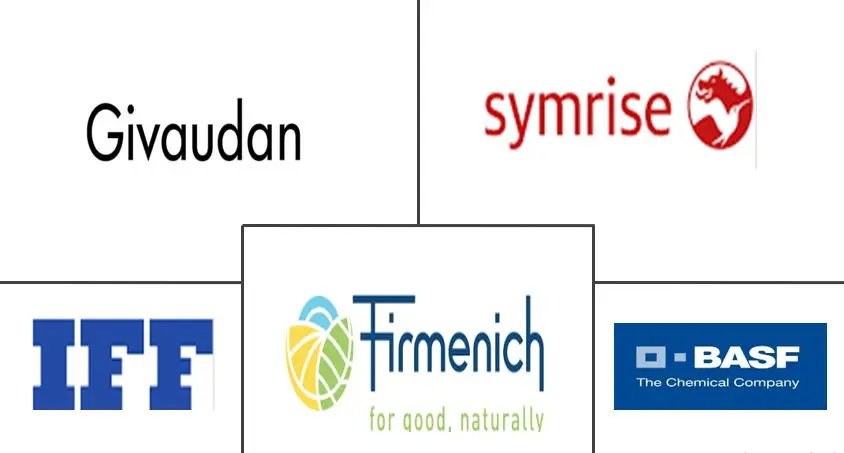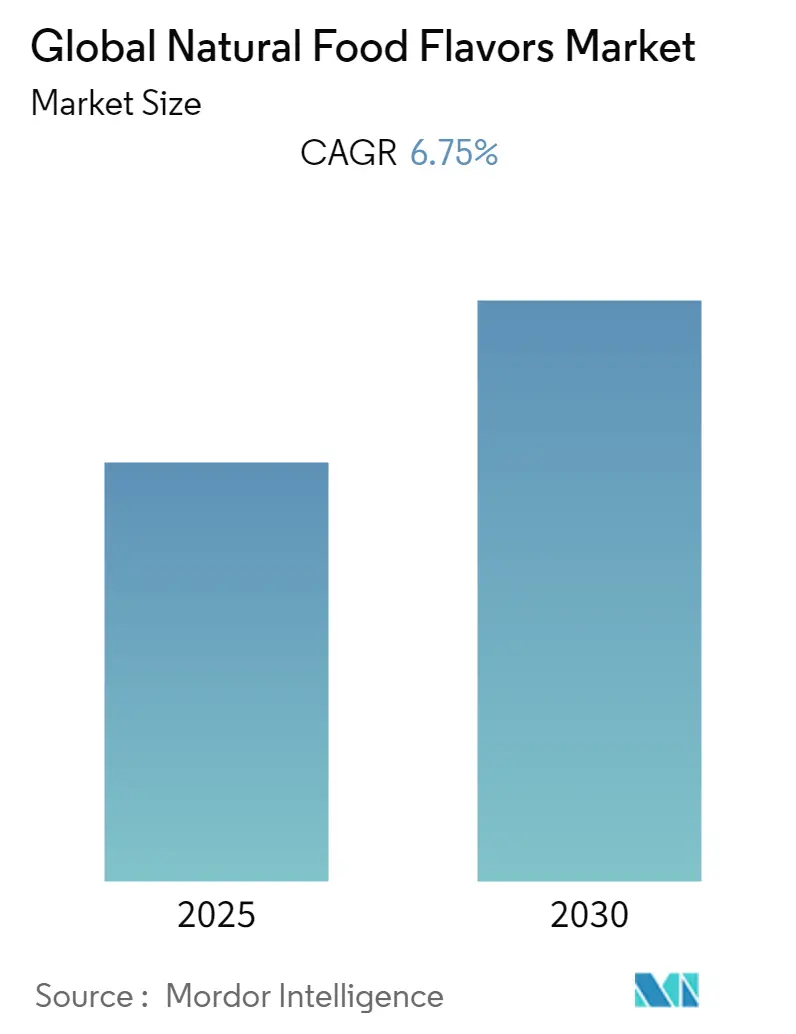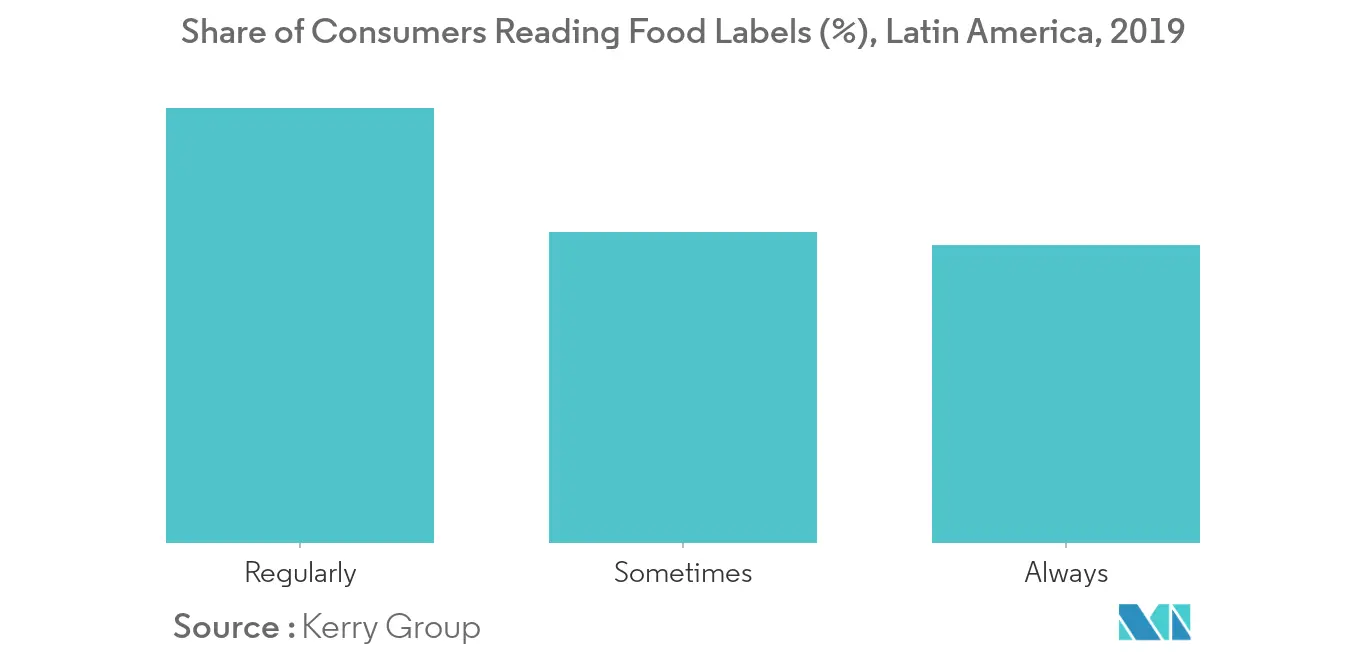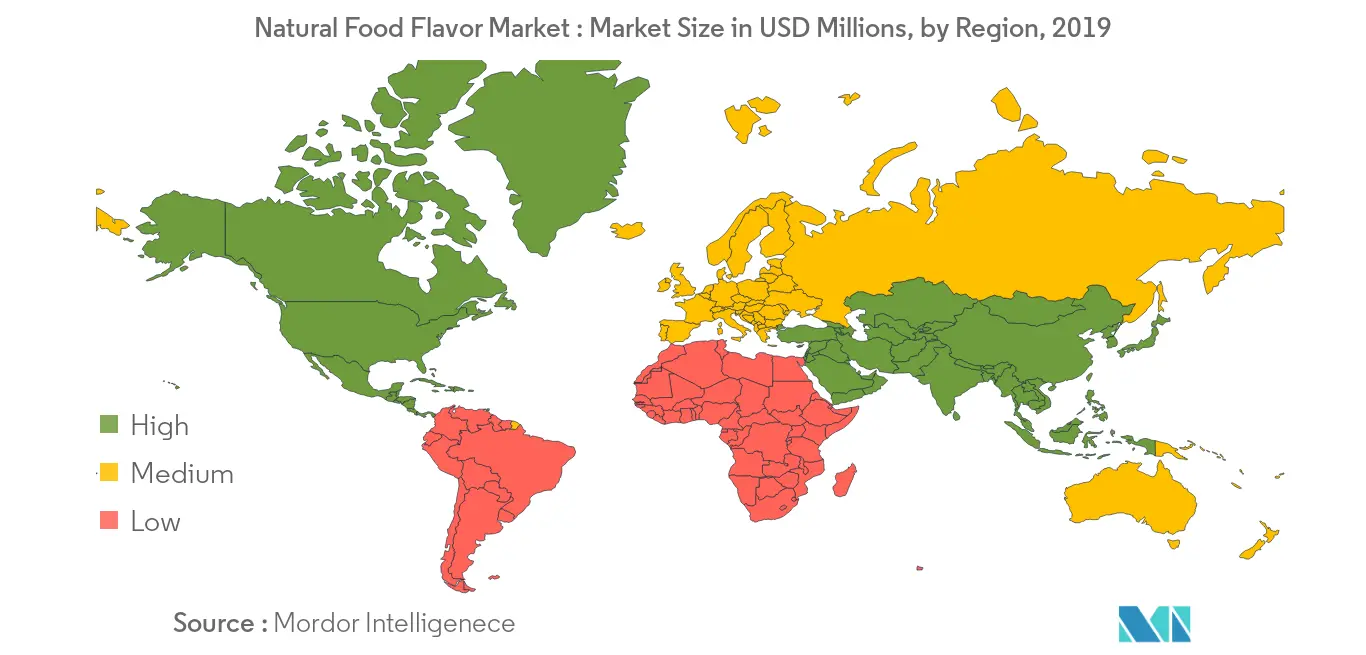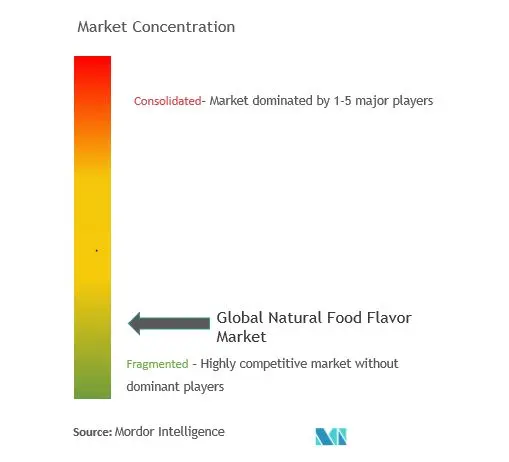Natural Food Flavors Market Size
Natural Food Flavors Market Analysis
The Global Natural Food Flavors Market is expected to register a CAGR of 6.75% during the forecast period.
- As per the International Food Information Council Foundation, the overall flavor industry runs due to consumer demand for the most nuanced and subtle flavors in food, with taste being a crucial factor influencing a consumer's purchase decision. The organization reveals that the importance of taste has increased since 2018, with about 86% of consumers choosing taste over other food attributes prior to their purchase. Along with the statement mentioned above, the demand for natural food flavors arises with the general consumer consensus to perceive food products as healthy if derived from natural ingredients.
- Moreover, consumers are greatly fascinated to use products with simple and understandable labels, which pushes food companies to opt for natural flavors that instantly gives a sense of relief to consumers, irrespective of its chemical association during production.
- However, high cost of extraction and expensive raw materials discourage food manufacturers, primarily in developing countries, to be as progressive as big firms and brands that are constantly rooting for healthier food products.
Natural Food Flavors Market Trends
Resurgance of Natural Food Products Among Consumers
The demand for global natural flavors is broadly driven by surging consumer consensus to perceive food products as healthy if derived from natural ingredients. With consumers now using both the terms synonymically, it often influences them to skip products formulated with artificial ingredients, further benefitting the market studied. It ensures that the same consumers are even keeping a constant check on food labels before purchasing. Several organizational surveys on consumer buying behavior reveal the rising consumer interest to probe for superior ingredients in the food label. According to the study published by the International Food Information Council Foundation, in 2019, about 59% of Americans claimed to always read labels on packaged food before buying it for the first time, with about 24% of them specifically look for specific claims, including natural formulation in the food product. This changing consumer behavior and market dynamics for food flavorings are pushing food manufacturers to quit formulating artificial additives in food products. Moreover, major food companies, such as Kellogg's, General Mills, Nestle, Campbell, and Kraft, have assured to restrict the use of artificial additives and flavors from their product formulations, portraying a promising future of natural flavors during the forecast period.
Asia Pacific Emerges As the Fastest Growing Market
The natural food flavor industry in Asia Pacific is exhibiting the highest growth rate oowing to the rising consumer awareness regarding the negative effects of synthetic flavors coupled with the growth in the spending abilities of the consumers in the region. The rising prominence of clean label ingredients with the label claims such as 100% natural, non-GMO, and organic in the Asian countries like China is boosting the demand of natural food additives such as natural food colorants, natural food flavors among others. The demand for these natural ingredients is increasing, due to the increasing health concerns of the customers, regarding the adverse health effects of artificial ingredients. Over the recent years, the demand for natural food flavors has increased among the Chinese consumers due to the influence of western-style cooking in China, which can be observed in the growing import for flavoring products, along with domestic consumption. For instance, in May 2020, PepsiCo is putting local culture and comfort at the heart of its NPD strategy in China with the launch of its first domestic market-inspired launch - an Osmanthus-flavored soft drink. Furthermore, amid the COVID-19 outbreak, the consumption of plant-based and natural products has increased drastically, owing to the huge demand for healthy food ingredients, and significant rise in the consumer awareness, boosting the demand for natural flavors in the region.
Natural Food Flavors Industry Overview
The leading participants include Givaudan, Firmenich SA, International Flavors & Fragrances, Symrise AG, and other companies. Givaudan led the market, with the highest share, in 2019.The prominent market players have been focusing on developing new and innovative p roducts by targeting new formulations for food flavors in the natural segment. Additionally, these companies are focusing on the increasing production capacities of their existing plants, while investing in R&D activities. Thus, the market studied is expected to witness a significant growth in product innovation, while keeping expansion as a business interest to reach a diverse set of consumers within a short-term period. As a part of its business expansion strategy, Givaudan expanded its geographical reach by opening a new technical and commercial center for flavors in Casablanca, Morocco. The CHF 1.2 million investment was part of the company's high growth market strategies. This also demonstrated its ongoing commitment to the Maghreb and West African regions
Natural Food Flavors Market Leaders
-
Givaudan SA
-
BASF SE
-
Symrise AG
-
International Flavors & Fragrances Inc. (IFF Inc.)
-
Firmenich SA
- *Disclaimer: Major Players sorted in no particular order
Natural Food Flavors Industry Segmentation
The report on the global natural food flavors market (henceforth, referred to as the 'market studied') offers key insights into the latest market developments. It analyzes recent trends, drivers, and challenges affecting the market studied across all the countries analyzed in the study. The global natural food flavors market is segmented by application and geography. By application, the market studied is segmented into bakery, confectionery, dairy and desserts, beverages, savory and snacks, meat and meat products, sauces, soups, and seasonings, and other applications. Furthermore, the report considers the market for meal replacement in established and emerging economies of North America, Europe, Asia-Pacific and rest of the world. The report contains top-line revenues and market share analysis of the key players, highlighting the most adopted strategies of the companies in the market studied
| By Application Type | Bakery | ||
| Confectionery | |||
| Dairy and Desserts | |||
| Beverages | Alcoholic | ||
| Non-alcoholic | |||
| Savory and Snacks | |||
| Meat and Meat Products | |||
| Sauces, Soups, and Seasonings | |||
| Other Applications | |||
| Geography | North America | United States | |
| Canada | |||
| Mexico | |||
| Rest of North America | |||
| Europe | Germany | ||
| United Kingdom | |||
| France | |||
| Spain | |||
| Italy | |||
| Rest of Europe | |||
| Asia Pacific | China | ||
| Japan | |||
| India | |||
| Australia | |||
| Rest of Asia-Pacific | |||
| Rest of the World | South America | ||
| Middle East & Africa | |||
| Bakery | |
| Confectionery | |
| Dairy and Desserts | |
| Beverages | Alcoholic |
| Non-alcoholic | |
| Savory and Snacks | |
| Meat and Meat Products | |
| Sauces, Soups, and Seasonings | |
| Other Applications |
| North America | United States |
| Canada | |
| Mexico | |
| Rest of North America | |
| Europe | Germany |
| United Kingdom | |
| France | |
| Spain | |
| Italy | |
| Rest of Europe | |
| Asia Pacific | China |
| Japan | |
| India | |
| Australia | |
| Rest of Asia-Pacific | |
| Rest of the World | South America |
| Middle East & Africa |
Natural Food Flavors Market Research FAQs
What is the current Global Natural Food Flavors Market size?
The Global Natural Food Flavors Market is projected to register a CAGR of 6.75% during the forecast period (2025-2030)
Who are the key players in Global Natural Food Flavors Market?
Givaudan SA, BASF SE, Symrise AG, International Flavors & Fragrances Inc. (IFF Inc.) and Firmenich SA are the major companies operating in the Global Natural Food Flavors Market.
Which is the fastest growing region in Global Natural Food Flavors Market?
Asia Pacific is estimated to grow at the highest CAGR over the forecast period (2025-2030).
Which region has the biggest share in Global Natural Food Flavors Market?
In 2025, the North America accounts for the largest market share in Global Natural Food Flavors Market.
What years does this Global Natural Food Flavors Market cover?
The report covers the Global Natural Food Flavors Market historical market size for years: 2019, 2020, 2021, 2022, 2023 and 2024. The report also forecasts the Global Natural Food Flavors Market size for years: 2025, 2026, 2027, 2028, 2029 and 2030.
Our Best Selling Reports
Organic Food Flavors Industry Report
Statistics for the 2025 Global Natural Food Flavors market share, size and revenue growth rate, created by Mordor Intelligence™ Industry Reports. Global Natural Food Flavors analysis includes a market forecast outlook for 2025 to 2030 and historical overview. Get a sample of this industry analysis as a free report PDF download.

